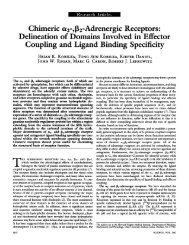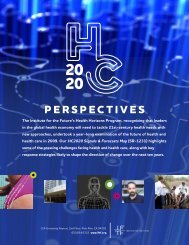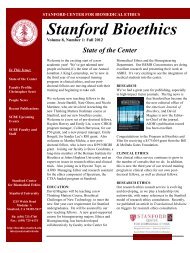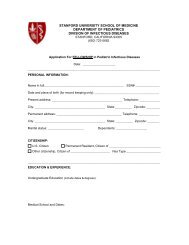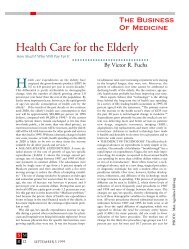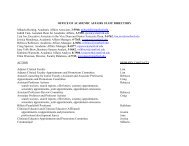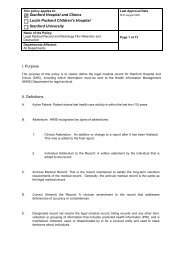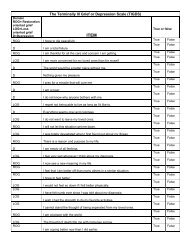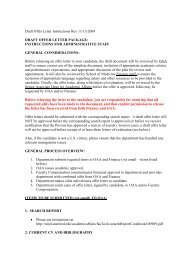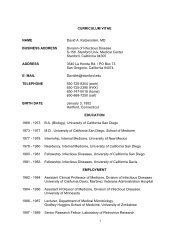HEAD & NECK SURGERY - Stanford University School of Medicine
HEAD & NECK SURGERY - Stanford University School of Medicine
HEAD & NECK SURGERY - Stanford University School of Medicine
You also want an ePaper? Increase the reach of your titles
YUMPU automatically turns print PDFs into web optimized ePapers that Google loves.
Non-invasive Diagnosis <strong>of</strong><br />
Cholesteatoma using High-Resolution<br />
Diffusion-Weighted MRI Sequences<br />
The Department <strong>of</strong> Otolaryngology, in<br />
conjunction with the Department <strong>of</strong> Radiology,<br />
is engaged in a prospective study<br />
to establish the efficacy <strong>of</strong> innovative MRI<br />
techniques in the diagnosis <strong>of</strong> cholesteatoma.<br />
Standard diffusion-weighted MRI is<br />
capable <strong>of</strong> detecting intratemporal squamous<br />
epithelium. However, it is suboptimal<br />
in its anatomic resolution and is<br />
subject to significant artifacts, both <strong>of</strong><br />
which limit its clinical utility.<br />
Our protocol involves the use <strong>of</strong> new signal<br />
processing techniques (SENSE-DWI).<br />
The resulting improved images have the<br />
potential to make MRI clinically useful in<br />
treatment planning for patients with<br />
possible occult cholesteatoma. Patients<br />
in whom a second-look procedure is<br />
contemplated may benefit greatly from<br />
this non-invasive imaging modality.<br />
Innovations in Cochlear Implant<br />
Technology<br />
In 1964, the first human multichannel<br />
cochlear implant was placed at <strong>Stanford</strong>.<br />
The Department <strong>of</strong> Otolaryngology continues<br />
this long history <strong>of</strong> innovation in<br />
the development<br />
and<br />
application<br />
<strong>of</strong> inner ear<br />
prostheses.<br />
Related<br />
basic science<br />
projects<br />
include the<br />
application<br />
<strong>of</strong> stem-cells for inner ear regeneration,<br />
computational modeling <strong>of</strong> inner ear<br />
function, and inner ear microendoscopy<br />
for therapeutics and inner ear microrobotics.<br />
The LPCH/<strong>Stanford</strong> Cochlear Implant<br />
Center is actively involved in clinical trials<br />
for cochlear implants. We are a center<br />
for the clinical trial <strong>of</strong> the Nucleus Electrical-Acoustic<br />
Hybrid implant.These devices<br />
<strong>of</strong>fer the potential benefits <strong>of</strong> cochlear<br />
implantation to the vast number <strong>of</strong> individuals<br />
who suffer from high frequency<br />
hearing loss, since residual acoustic hearing<br />
in the lower frequencies can be<br />
maintained.<br />
CLINICAL RESEARCH IN<br />
AUDIOLOGY<br />
Gerald Popelka, PhD<br />
Clinical research in Audiology complements<br />
the services that are provided and<br />
consequently covers both diagnostics<br />
and rehabilitation. All clinical audiology<br />
research is performed under strict IRB<br />
protocols with patients providing signed<br />
consents and receiving compensation in<br />
most cases and complete protection <strong>of</strong><br />
patient privacy<br />
Our current auditory diagnostic research<br />
projects center around the development<br />
and improvement <strong>of</strong> clinical information<br />
derived from auditory evoked potentials.<br />
A new auditory evoked potential measure<br />
reported last year has the possibility<br />
<strong>of</strong> indicating whether cochlear fluid<br />
pressure is abnormally high. The measure<br />
is based on the theory that a prominent<br />
peak in the waveform <strong>of</strong> the auditory<br />
brainstem response will shift in<br />
latency (about 1 msec) with selective<br />
stimulation <strong>of</strong> different portions <strong>of</strong> the<br />
basilar membrane. This latency shift is<br />
due primarily to the normal stiffness gradient<br />
along the length <strong>of</strong> the basilar<br />
membrane. High fluid pressure such as<br />
that associated with endolymphatic<br />
hydrops is expected to eliminate this<br />
gradient stiffness and therefore eliminate<br />
the latency shift. Currently, several<br />
parametric variables are being investigated<br />
including electrode location, automated<br />
response quantification, methods<br />
for reducing electromyogenic artifacts,<br />
and other practical considerations before<br />
the method can be deemed reliable<br />
Fall 2006<br />
enough for routine clinical use. It is<br />
hoped that the improved procedure will<br />
provide a repeatable and useful indication<br />
<strong>of</strong> cochlear fluid pressure.<br />
Our current rehabilitative research projects<br />
center on the development <strong>of</strong><br />
advanced digital signal processing that<br />
can be implemented with contemporary<br />
digital hearing aids. These advanced<br />
hearing aids now constitute over 90% <strong>of</strong><br />
all hearing aids sold nationally and 100%<br />
<strong>of</strong> those dispensed in our clinic and continue<br />
to add new functionality such as<br />
incorporating cell phone capability.<br />
Current research projects involve both<br />
the development <strong>of</strong> new digital processing<br />
for improving speech understanding<br />
in noise and measuring and understanding<br />
the sources <strong>of</strong> alterations in other<br />
auditory tasks caused by the specific digital<br />
processing such as errors in locating<br />
sounds in the environment. We wish to<br />
make sure that an enhancement in one<br />
type <strong>of</strong> auditory performance, improved<br />
understanding in noise, eg, is not<br />
obtained at the expense <strong>of</strong> a detriment<br />
in another type <strong>of</strong> auditory performance,<br />
poor speech understanding through the<br />
internal cell phone function, eg. We also<br />
wish to determine if the particular digital<br />
processing interacts with the individual<br />
hearing status such that a particular processing<br />
may be beneficial for certain<br />
types <strong>of</strong> hearing impairment but detrimental<br />
for other<br />
types <strong>of</strong> hearing<br />
impairment.<br />
Patients with well<br />
documented hearing<br />
loss are<br />
recruited to listen<br />
to speech and<br />
other sounds<br />
processed digitally<br />
under highly-controlled<br />
conditions<br />
either in real time<br />
or with prerecordedrecordings.<br />
It is hoped<br />
that this systematic<br />
approach will result in an understanding<br />
<strong>of</strong> the optimal digital processing for<br />
individual patients allowing us to fulfill<br />
our goal <strong>of</strong> providing customized and<br />
optimized solutions for our hearing<br />
impaired patients.<br />
15





